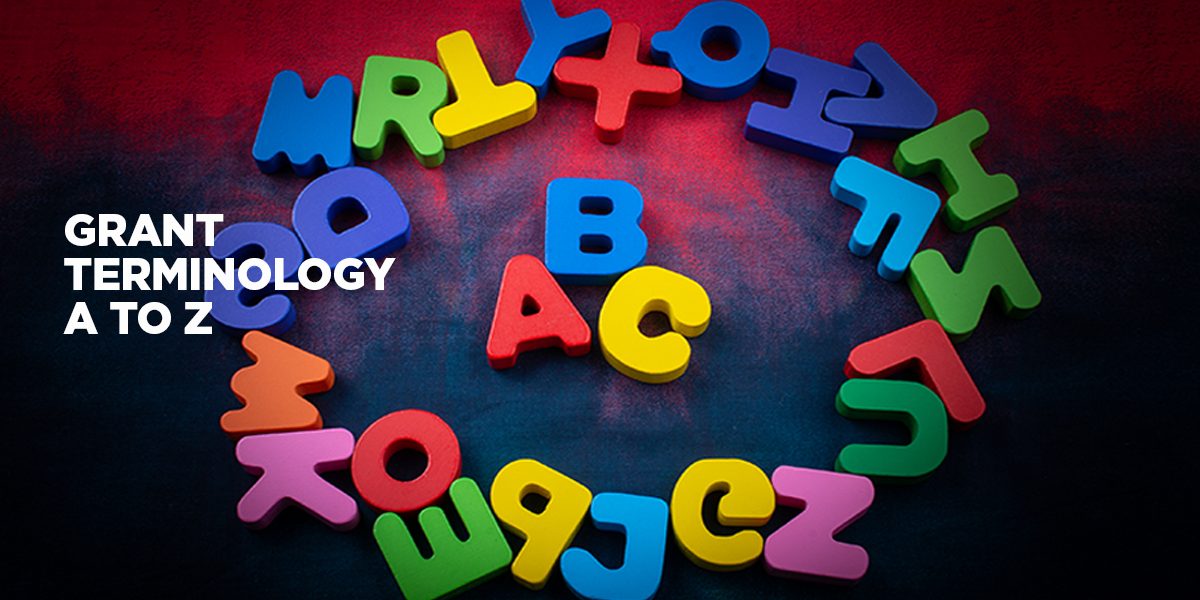So, you want to write a grant! You know the importance of the mission you want to support, and you have the drive to succeed. That’s a start. However, do you know the A to Z grant terminology needed to convince a prospective donor to fund your project over some other worthy cause? GrantWriterTeam has some pointers for anyone just starting their grant-writing journey. Without a doubt, A to Z key grant terms are strong and effective, and they will help you convey the value of your cause.
Given that you are competing with other applicants, it’s imperative to make your foundation stand out from the crowd. Still, you may ask how important are the elements of grant terminology in grant writing. Does knowing the correct terminology really matter? Yes, yes it does. In fact, utilizing proper grant terminology is vital to the success of any grant proposal. While we admit to taking poetic license with one or two of the terms below, the following list of A to Z key grant terms will help make your grant proposal even better.
A to I
A. Application: Thoroughly review to ensure proper steps and guidelines are followed when writing the grant proposal.
B. Budget: Be clear in advance. There MUST be a budget for writing your grant proposal. Stay within that budget.
C. Close Date: This deadline is designated by a grant funder. Always submit our grant application by this date.
D. Date of Completion: The designated time funder sponsorship ends and all work on a grant-funded project is completed.
E. Earmarked: Grants designated for a specific purpose. Using the funds for another purpose could cause the grant to be rescinded.
F to J
F. Funding Period: The period of time during which a grant funding award is available for the recipient to utilize.
G. Grantor: Agency or other entity that provides grant funding opportunities based on a set of criteria established by the Grantor.
H. Hedge: You should ‘hedge your bets’ by submitting multiple grant proposals to increase the chances of winning a grant award.
I. Institutions of Higher Education (IHEs): A nationally accredited public or nonprofit institution providing instruction beyond secondary education.
J. Joint Venture (JV): Two like-minded strategic partnership organizations working together to strengthen grant award submissions.
K to O
K. Key personnel: Individuals within an organization vital to the substantive, measurable development or execution of a project or program.
L. Letter of Intent (LOI): Often the first step in a grant application process for some private funding sources (i.e. corporations and foundations).
M. Matching Grant: Applicant provides the same amount (of funding) – usually provided by donors – to qualify for a grant award.
N. Notice of Award (NoA): Official notice to grant applicants. This award letter includes the funding amount and terms and conditions.
O. Organization Applicant: Submitting a grant on behalf of an organization which, if nonprofit, must be an IRS-registered 501(c)(3) entity,
P to T
P. Pass-Through Funding: Grant funding that is passed through an intermediary agency or agent to the ultimate grant recipient.
Q. Quota: A goal; most likely a goal required in order to retain some or all of the grant award.
R. Recipient: An individual, nonprofit, or small business responsible and accountable for the intended purpose of a grant they receive.
S. Social Responsibility: Nonprofits have inherent obligations to be accountable and provide transparency with grants they are awarded.
T. Trust: Responsible handling of a current grant fund award is critical to improved prospects for future grant-funding awards success..
U to X
U. User: The grantee’s obligation for financial supervision and proper staffing ensures the best benefits to the user.
V. Value Proposition: Successful grants embody the mission statement goal and grant benefit to provide value over other proposals.
W. White Paper: Nonprofits use these documents to market and/or otherwise promote the benefits or services they offer.
X. X-efficiency: X-efficiency is the degree of efficiency with which an organization maximizes its product or services with limited resources.
Y and Z
Y. You: This a Power Word. “Using the word ‘you’ brings it home to people that they’re involved. That we’re all connected and adds responsibility for being part of ‘the change they want to see in the world,’ to quote Mahatma Gandhi. According to a study by Yale University’s psychology department, using the word ‘you’ instantly addresses the reader and gets their attention. It makes your request more personal, direct, and compelling.
Libby Hikind suggests starting your own powerful word list filled with positive action words you are comfortable with and keeping the one page at your fingertips …” (GrantWriterTeam, Do You Have a Power Word List To Use For Winning Grant Proposals)
Z. Zero-sum Game: Limited grant funds means there will be funded grants and grants not funded. Hope you can now win a funded grant!
About GrantWriterTeam
Are you a nonprofit or small business in need of some help? If you are searching for grants but are feeling overwhelmed, hiring a grant writer may be the perfect choice for you! Grant writers thoughtfully grant opportunities and consider the pros and cons of applying and the chance of success. Consider your writer an extension of your organization. They will coach you throughout the entire process and curate the project to fit your needs. Your grant-seeking success is our priority at GrantWriterTeam.

Recent Comments